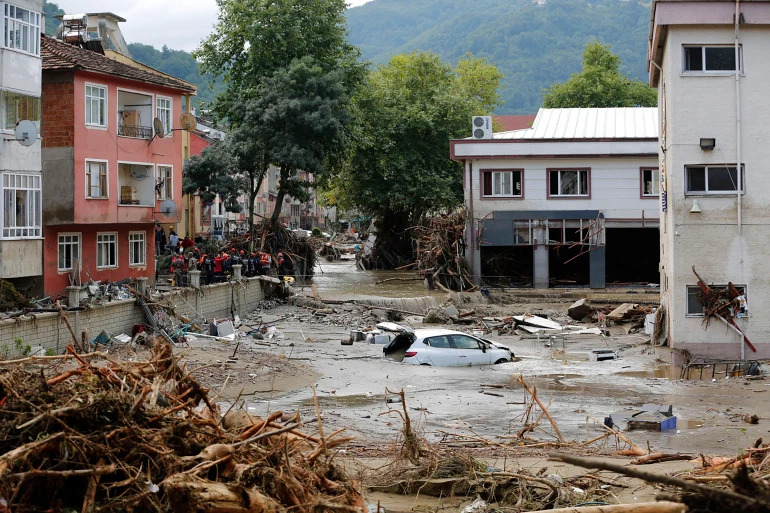
The death toll from northern Turkey’s flash floods and mudslides soared to 38 as President Recep Tayyip Erdogan visited one of the hardest-hit cities to lead a prayer for the victims and pledge government help.
The floods battered the Black Sea coastal provinces of Bartin, Kastamonu, Sinop and Samsun on Wednesday, demolishing homes and bridges and sweeping away cars. Hundreds of people were rescued by helicopters while 1,700 others were evacuated.
“The destruction is huge,” Kerem Kinik, head of the Turkish Red Crescent, told NTV. “I hope that the missing are safe and that the number of deaths doesn’t increase.”
Health Minister Fahrettin Koca announced on Twitter late Friday that 32 people died in Kastamonu and six in Sinop.
Floodwaters inundated much of the town of Bozkurt, in Kastamonu, where one building collapsed and a second structure was severely damaged. In Bartin province, at least 13 people were injured when a section of a bridge caved in.
Bozkurt resident Yilmaz Ersevenli told NTV he left his house to move his car to a safe area as the waters began to rise, but soon got swept away by the gushing floods. He managed to save himself by holding on to a tree that had also washed away.
“I nearly lost my life trying to save my car,” he said.
The Disaster and Emergency Management Presidency, or AFAD, said rescuers recovered 10 more bodies in worst-hit Kastamonu on Friday. An 80-year-old woman was reported missing in Bartin province.
More than 5,000 personnel, 19 helicopters and 500 vehicles were involved in rescue efforts, backed by NGOs and the military.
Five bridges collapsed in the floods while two others were damaged, AFAD said. Hundreds of villages were left without power and several roads were blocked.
Speaking in Bozkurt late Thursday, Interior Minister Suleyman Soylu described the scenes as “the most severe flood disaster I have seen”.

Turkey’s meteorology authority said further heavy rain was expected in the central and eastern Black Sea region and warned of the risk of further floods.
Sinop Mayor Baris Ayhan put the death toll in his province at three, adding authorities could not contact another 20 people. He urged the government to declare it a disaster zone.
“The infrastructure in Ayancik [district] has completely collapsed. The sewage system is destroyed. There is no electricity or water,” he said.
Erdogan sounded both mournful and hopeful as he attended a funeral for the first victims and led a prayer before a few hundred residents in the inundated city of Kastamonu.
“We will do whatever we can as a state as quickly as we can, and rise from the ashes,” Erdogan told the crowd.
“We can’t bring back the citizens we lost, but our state has the means and power to compensate those who lost loved ones.”
Turkey’s Black Sea region is frequently struck by severe rains and flash flooding. At least six people were killed in floods that hit the eastern Black Sea coastal province of Rize last month.
The disaster struck as firefighters in southwest Turkey worked to extinguish a wildfire in Mugla province, an area popular with tourists that runs along the Aegean Sea.
The blaze, which was brought under control on Thursday, was one of more than 200 wildfires in Turkey since July 28.
At least eight people died and thousands of residents have had to flee fierce blazes.
The floods and fires struck in the same week a UN panel said global warming was dangerously close to spiralling out of control, and warned that extreme weather would become more severe.
Climate scientists say there is little doubt that climate change from the burning of coal, oil and natural gas is driving more extreme events, such as heat waves, droughts, wildfires, floods and storms.
Such calamities are expected to happen more frequently as the planet warms.